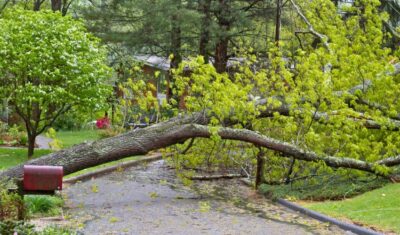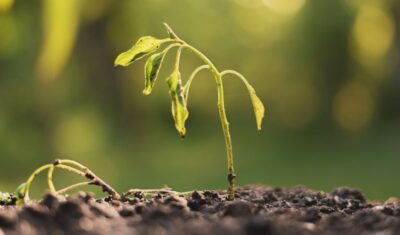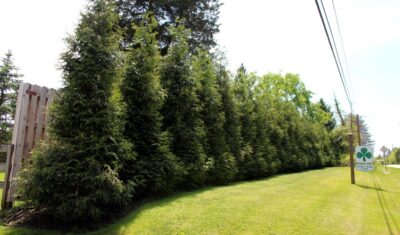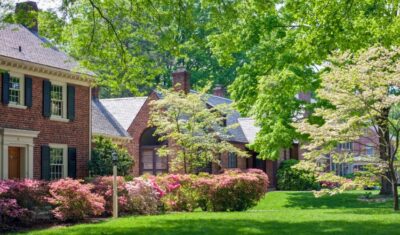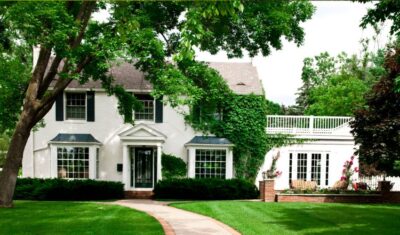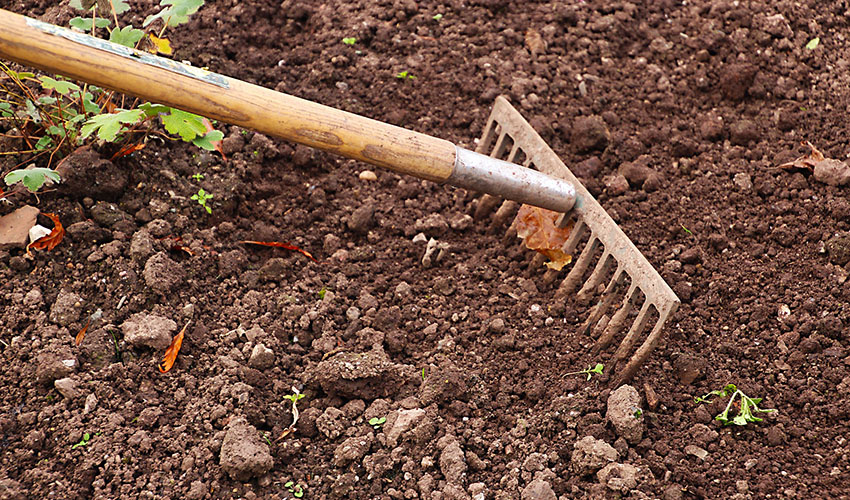
When looking at trees, shrubs, or other plants, we often focus on what we can see above ground. But it’s what’s beneath a plant – the health of the surrounding soil – that has the biggest impact on its health and appearance.
Keep your trees healthy by learning what soil is, how to identify healthy soil, ways to improve poor soil (most urban and suburban soil falls in this category), fertilizer use, and more.
It’s just dirt, right?
Don’t call it dirt! Soil is a complex, living thing that is vital to our planet, our lives, and to our trees. Healthy, living soil is often the result of good geologic ancestry and of careful stewardship, but even poor soils can be given new life if they’re treated right.
What is soil, exactly?
Soil is a mixture of several naturally-occurring things:
- Minerals, from years of eroded rock formations (classified as sand, silt, or clay)
- Air molecules
- Water molecules
- Organic matter from years of decayed plant and animal material
Some soils are billions of years old, some are only tens of thousands of years old—it depends on the natural forces that made them. Glaciers, for example, were notorious for sliding away and taking all the soil with them, while rivers like the Mississippi continue to dump soil in the form of a sediment delta as its waters meet the ocean.
Are there different types of soil?
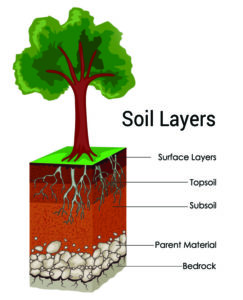
Soil classifications are based on the percentages of sand, silt, and clay found in a soil sample, and make up a soil’s texture. Sand, silt, and clay particles have naturally different sizes, with sand being the largest and clay being the smallest. In soils, they bond together into peds, naturally forming clumps.
I’ve heard the term “living soil.” What does that mean?
The reason why healthy soils are described as “living” is because in healthy soil you’ll also find countless beneficial bacteria, fungi, and other living organisms among the soil components.
Is there such a thing as bad soil?
The texture of a soil can’t be changed, but its structure can – for better or for worse.
The way to wreck a soil’s structure is through compaction, which compresses soil particles together and makes them impervious to water and aeration.
Soil structure can also be ruined by “puddling,” which is like compaction but much worse. Puddling occurs when soil has been overworked and its particles have all separated, with the tiny clay particles clogging spaces that used to hold water and air. This is when soil becomes inert, or dirt.
Soil becomes overworked through:
- Excessive tilling or cultivating
- Tilling or digging wet soil
- Death of soil microorganisms from exposing deeper soil to surface air and light
- Compaction from excessive traffic by heavy machinery
These practices, plus a reliance on fast-acting synthetic fertilizers, are some of the main culprits in soil damage and exhaustion.
My home is surrounded by urban fill. What’s that?
Urban fill is the name sometimes given to the potpourri of materials that make up the soil found in cities and suburbs, where long-term and extensive soil disturbance has occurred. Sometimes this material is valuable, such as when historical artifacts are uncovered during excavation, but the majority of it is garbage, literally. Bottles, cans, nails, broken concrete, glass –anything, really—are found, as well as the residue of harmful chemicals that were dumped or leached into the native soil.
The main problem with urban fill is that there’s only a small volume of actual, fertile soil because there are so many other inert or damaging components in its mass.
What about subsoil? Can I use that in my garden?
Another reason is that urban soil we find at the surface, such as in a suburban garden, may be made up of subsoil excavated from a lower soil level, or soil horizon, when the site was graded and the house built. Subsoil is generally made up of sand, silt, and clay, along with larger un-eroded rocks, but it lacks the decayed organic matter that makes soil both fertile and crumbly (and brown). Sometimes you can identify subsoil by its gray appearance, its sticky, slick, or rocky feel, and by its conglomeration of un-eroded material.
When subsoil is used as planting soil, it has little to no fertility that will support long-term tree growth. New homeowners often discover this when their new trees and landscape have wilted, yellowing leaves, scant leaf output, stunted growth, or no growth at all. These are symptoms of nutrient deficiency. Synthetic fertilizer may have been added at planting, or a small quantity of soil amendment, but these short-term solutions are just that – trees will quickly use them up and need more.
What kind of soil do trees need?
If your trees and shrubs are suffering but there’s no evidence of insect pests or diseases, we usually turn to your soil as a reason for their stress.
Trees need healthy soil, and lots of it, to grow the extensive root system they need for water, nutrients, and stability, as well as the leafy crown needed for photosynthesis and transpiration.
Trees also need water. Fertile, healthy soil naturally holds more water molecules than poor soil, so trees don’t experience water stress as frequently or as severely, and potable irrigation water is conserved.
In undisturbed forests and woodlands, native soil has benefited from millennia of soil amendments in the form of dropped leaves and decaying wood, which have entered the soil and bonded to particles to become part of the available nutrients for tree roots to exploit. But in urban and suburban settings, it’s up to you to improve your soil, starting with its structure.
Can soil structure be improved?
Yes, soil structure can be improved! And it’s pretty easy, depending on the starting condition of your soil.
In contrast to the practices that damage your soil, here’s how to improve soil structure:
- Limit soil disturbance from tilling
- Leave natural soil peds in place
- Do not till or cultivate very wet or saturated soils
- Amend soil with organic matter
These practices strengthen the structure of soil by supporting its natural structure and its microbial life.
How can I improve the overall health of my soil?
First, make sure you’re not damaging the soil’s natural structure.
Then, if you think your soil is poor or infertile, you might want to do a professional soil evaluation. A soil analysis or soil test will tell you what your soil is made of and what it needs to support healthy plant growth.
We can help you interpret a soil test’s data and can give you customized soil amendments and fertilization methods that work for your property’s particular needs.
What about adding amendments or fertilizer to my soil?
Chief among the beneficial practices for soil health is the addition of organic matter in the form of compost and mulch. As organic matter breaks down, its tiny particles are carried by water through the soil where they bond to existing soil particles. This is how soil structure is improved and how soil fertility is achieved.
Organic fertilizer can also be used to improve tree health and vitality. We inject it directly into the soil in the tree’s root zone where some is quickly taken up by the tree while the rest bonds with existing soil particles so it remains available over the longer term. Studies have shown that with the right fertilization, plants and trees are more resistant to disease and insects.
In comparison, synthetic, water-soluble fertilizers are immediately available to plant roots and do not remain in the soil. This means there is no long-term benefit—or any benefit—for the soil itself, and is how the cycle of reliance on synthetic fertilizers starts and perpetuates itself.
To learn more about how organic fertilization helps your plants, as well as the soil, check out these blog posts:
- How deep root fertilization helps struggling trees
- Benefits of organic spring fertilization
- Fertilization FAQs: What, what, why & how
Need some help?
If your trees are showing signs of stress or nutrient deficiency (such as wilted, yellowing leaves, scant leaf output, stunted growth, or no growth at all), give us a call or use our online form to request an appointment with a Certified Arborist. We can quickly determine the cause of the problem and recommend a solution. If it appears to be a soil issue, it can be remedied through organic fertilization and/or amendments.
Is Your Soil Healthy?
If your trees or plants are struggling, it may be due to the quality of your soil. Contact Independent Tree to determine if your soil is an issue and to go over options for how to improve your soil and the health of your plants and trees.Recent Articles
Topics
About The Author

STAY IN THE LOOP
WITH OUR
LATEST UPDATES
"*" indicates required fields

